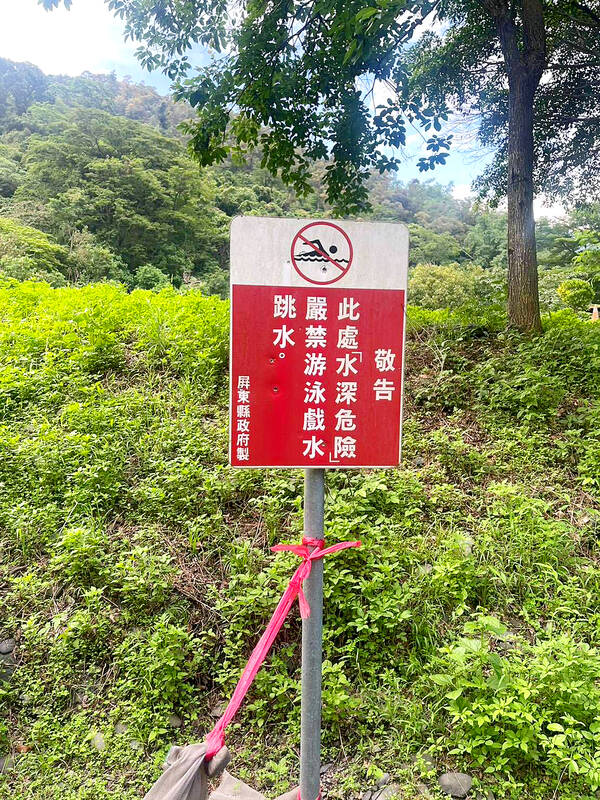Three men from Kaohsiung drowned on Wednesday while allegedly swimming in a mountain stream at Haishengong (海神宮), a popular, but restricted scenic spot in Pingtung County’s Sandimen Township (三地門), local authorities said yesterday.
Pingtung prosecutors said a postmortem examination, which was completed at about noon yesterday, found the three men died from drowning and no suspicious injuries were found.
The postmortem examination report was released to the relatives of the victims, prosecutors said, adding that they had no comment on the cause of death.

Photo courtesy of the Pingtung County Government
The Pingtung County Bureau of Fire and Emergency Services received a report at 3:23pm that several people were drowning at a location about a 30-minute hike from the Haishengong parking lot.
Rescue teams were immediately dispatched to the site and emergency responders pulled the three men from the stream, but none showed vital signs at the scene, bureau head Lee Pin-cheng (李彬正) said.
They were rushed to hospital, but later pronounced dead.
Police identified the victims as two 44-year-old men surnamed Huang (黃) and Kuo (郭), and a 38-year-old man surnamed Lin (林). The three had traveled together from Kaohsiung to spend the day at Haishengong, authorities said.
Officials said that Haishengong is on private land and is not open to the public.
Rainfall in the mountains during the plum rain and summer flood seasons can quickly cause flash floods, making the area especially dangerous, said officials, who urged visitors to stay away from the site.
More than 20 landowners of Haishengong were to join a meeting last night to discuss how to manage the place, said Hua Hsiu-chin (華秀琴), tourism division director of the Sandimen Township office.
According to fire bureau records, four incidents have occurred at Haishengong in the past five years, resulting in six deaths and one injury.
Additional reporting by Fion Khan

Three batches of banana sauce imported from the Philippines were intercepted at the border after they were found to contain the banned industrial dye Orange G, the Food and Drug Administration (FDA) said yesterday. From today through Sept. 2 next year, all seasoning sauces from the Philippines are to be subject to the FDA’s strictest border inspection, meaning 100 percent testing for illegal dyes before entry is allowed, it said in a statement. Orange G is an industrial coloring agent that is not permitted for food use in Taiwan or internationally, said Cheng Wei-chih (鄭維智), head of the FDA’s Northern Center for

The Chinese military has built landing bridge ships designed to expand its amphibious options for a potential assault on Taiwan, but their combat effectiveness is limited due to their high vulnerability, a defense expert said in an analysis published on Monday. Shen Ming-shih (沈明室), a research fellow at the Institute for National Defense and Security Research, said that the deployment of such vessels as part of the Chinese People’s Liberation Army (PLA) Navy’s East Sea Fleet signals a strong focus on Taiwan. However, the ships are highly vulnerable to precision strikes, which means they could be destroyed before they achieve their intended

About 4.2 million tourist arrivals were recorded in the first half of this year, a 10 percent increase from the same period last year, the Tourism Administration said yesterday. The growth continues to be consistent, with the fourth quarter of this year expected to be the peak in Taiwan, the agency said, adding that it plans to promote Taiwan overseas via partnerships and major events. From January to June, 9.14 million international departures were recorded from Taiwan, an 11 percent increase from the same period last year, with 3.3 million headed for Japan, 1.52 million for China and 832,962 to South Korea,

REWRITING HISTORY: China has been advocating a ‘correct’ interpretation of the victory over Japan that brings the CCP’s contributions to the forefront, an expert said An elderly Chinese war veteran’s shin still bears the mark of a bullet wound he sustained when fighting the Japanese as a teenager, a year before the end of World War II. Eighty years on, Li Jinshui’s scar remains as testimony to the bravery of Chinese troops in a conflict that killed millions of their people. However, the story behind China’s overthrow of the brutal Japanese occupation is deeply contested. Historians broadly agree that credit for victory lies primarily with the Chinese Nationalist Party (KMT)-led Republic of China (ROC) Army. Its leader, Chiang Kai-shek (蔣介石), fled to Taiwan in 1949 after losing a